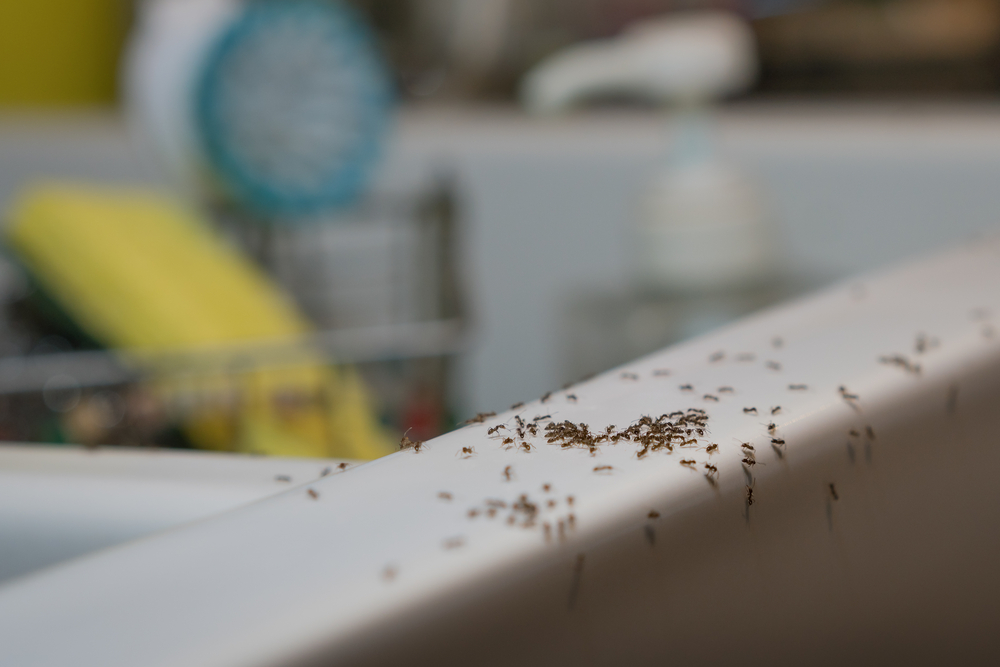
March 5, 2023
11 Ways to Get Rid of Ants in Your Kitchen
As the weather gets warmer, we all should be ready for the crazy creepy-crawly show in our kitchens. Household ants usually get in our homes through the floor, door, or window cracks, seduced by food and water a messy kitchen can generously provide. Smashing ants right on the spot does not make the situation any better. The point is that ants are not lone hunters. They are natural-born team players living in colonies (also referred to as “superorganisms”). They inform each other about the food source by emitting pheromones on their track. So even if you kill one or two, many more will follow the path and soon be in your kitchen. In this post, we will tell you how to deal with the whole colony (including its queen) and stop the ant problem in your kitchen once and for good.
What drives ants to your home?
- Food. An ant colony needs food to survive and multiply. The sweeter, the better. You must have noticed that fruits, sweets, or sweet sticky spills (such as honey, juice, ice cream, or syrup) you left unattended overnight get covered with creepy crawlies. Also, they do not disdain fatty and oily foods, which points to the fact that they are hunting for calories to keep the whole queen’s army working and in good health.
- Water. Besides food, ants need water, and they usually find plenty of it near sinks and appliances, on the counters, and on the windowsills.
- Unfavorable weather. Ants usually come out of hibernation in spring as the days get warmer and feel okay outside. Still, heavy rains, heat, or excessive dryness can drive them indoors to pursue more comfortable conditions.
So, if ants find food, water, and reliable shelter in your kitchen, they can stick around for as long as you are ready to stand them.
How to stop the ant problem once and for good?
1. Discover the nest
To determine where the colony’s nest is located, just watch the ants moving. Now that you know about their habit of following the same pheromone-marked tracks, it will be easy for you to notice their entry and escape spots. They can get in your kitchen through the door or window gaps, holes in window screens, or cracks in wooden floors. Do not try to seal these entryways now. You will do it later after the colony is destroyed to prevent future re-appearances.
Watching ants’ tracks will help you find the colony’s nest, which is usually under the floor, inside the wet walls, in appliances, kitchen cabinets, or outdoors (on a tree or in the ground).
2. Use non-repellent pesticides
Before you start your nest search, prepare a non-repellent pesticide, so you can kill the whole colony at once. (Using a repellent spray, in this case, is ineffective because the scattered ants will reunite in a colony elsewhere again.) Be careful while using the pesticide and read the precautions. It is usually made of harsh chemicals that are toxic to not only ants but also children and pets.
Is there a non-toxic option? Boiling water can effectively ruin the nest and “cook” the whole colony inside it. However, this method requires some extra caution from your side. It can be difficult to apply on vertical surfaces (such as a wall) or can cause damage to your kitchen furniture.
If you cannot find the nest or get to it, the methods listed below will help.
3. Use store-bought ant traps
The most effective method of killing the whole colony at a distance is to use traps containing sweet food (corn syrup, for example) mixed with a slow-acting poison like borax. The idea is to make the ant eat the poisoned food on the place and bring it home to share with the queen and her little ones. Put a trap along the usual ant tracks or as closer to the entry spot as possible. Ensure you leave no other food that would distract them. Commercial traps can also go in gel form, so they can be applied on the surfaces where you usually spot ants. Be patient because the effect will be visible only in a few days.
4. Try homemade ant traps with borax
This easy homemade trap is effective on the whole colony, including eggs. Mix sugar and borax in equal parts and add two parts water. If you just leave this mixture in a small container on the ant track, the moisture will evaporate quickly. So better soak cotton pads or balls in this solution and leave them on the ant tracks. Ensure you wash your hands afterward and that your kids or pets cannot access the improvised traps.
5. Use a soapy spray
If, after poisoning the colony, you keep spotting lonely ants running here and there, you can deal with them quickly. No, not with a chemicals-loaded ant killer spray because you do not want the chemicals to get on food and surfaces your kids and pets have contact with. Instead, mix 1 cup water and 1 cup vinegar in a spray bottle and add 1-2 tablespoons of dish soap. Spay this mixture over the ants on a counter and wipe them away easily.
By the way, we recommend saving this recipe because it is actually a powerful, cheap, and natural multi-purpose cleaner. It easily copes with dirty windows, food messes on counters, light grease, and soap scum in a kitchen sink.
6. Use vinegar to clean your kitchen
Now that you have dealt with the ant problem at its source, it is time to ant-proof your home. And the first step to an ant-free house is a thorough kitchen cleaning, preferably using vinegar as a cleaning agent. Why vinegar? It destroys the pheromone tracks created by ants and acts as a natural ant repellent (they cannot stand the smell).
- Use the vinegar-based all-purpose spray we mentioned above to clean appliances, tiles, kitchen cabinets, and floors. However, use it carefully when cleaning quartz counters or rinse them thoroughly with water afterward.
- Ensure you clean behind and under appliances to remove crumbs and other food leftovers that can attract unwanted visitors.
- Clean and disinfect the trash can and keep its lid shut when not in use. Do not leave trash indoors for longer than two-three days.
7. Keep food stored and sealed properly
All the above-mentioned measures would be ineffective if you kept leaving food or drinks unsealed in the kitchen. Make it a habit to return food to the fridge right after you are done with your meal. Clean the food messes immediately and store all the rest foods in air-tight reusable containers. The idea is to not let the ants smell a food source in your home. Also, keep your pet feeding area clean because pet food leftovers can attract ants too.
8. Avoid moisture in the kitchen
Inspect your kitchen plumbing system and appliances for leakages and do the required repairs to not seduce ants with free drinks. Avoid soaking dishes in the sink for too long and keep your sink as clean and dry as possible. Dry the wet towels and wipe away water spills immediately because what is not enough for a human can be a full cup for an ant. Thirsty and hungry ants will soon forget the way to your home.
9. Use lemon and orange
Natural ant repellents such as lemon, orange, peppermint oil, and cinnamon will help ward off ants from your kitchen. Put the orange or lemon peels near the ant entry spots or squeeze some lemon juice on the wet mop and wash the floor to create a natural barrier ants cannot overcome. Beware of using citrus juice on the counters because acids can cause damage to some types of countertop materials, for example, quartz.
10. Use pepper
Pepper (black or cayenne) belongs to the flavors ants hate, so sprinkling some pepper near the nest or entry spot will make the six-legged sweet teeth dislike your kitchen forever.
11. Hire a professional pest control company
If the ant invasion gets out of hand or you do not have time or mood for the ant hunt, you can always rely on pest control experts. They know the ant habits and have the tools to eradicate the ant problem for good.
